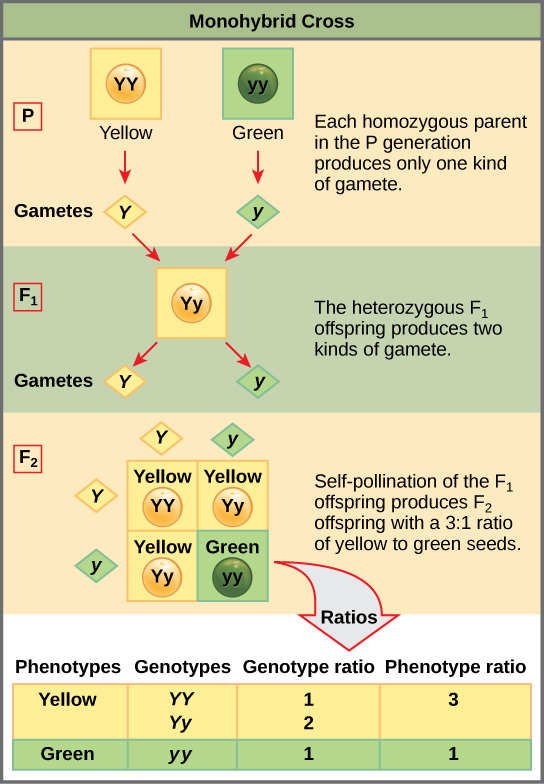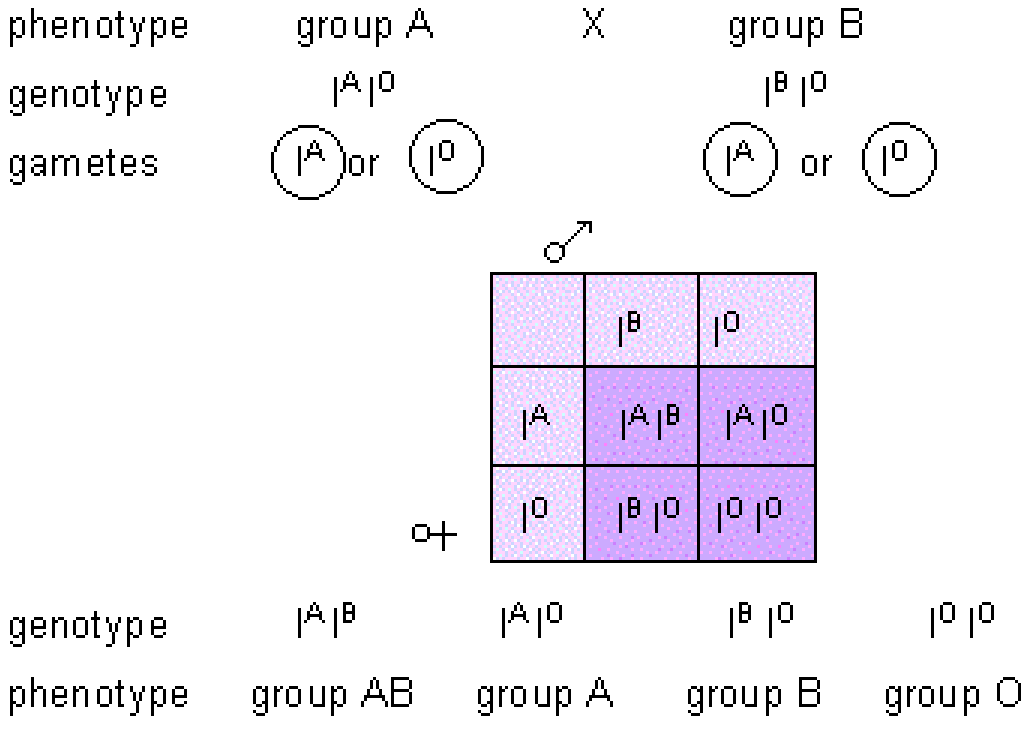16.06 Monohybrid Inheritance and Genetic Diagrams
Monohybrid Inheritance
1. Definition
- Monohybrid Inheritance refers to the pattern of inheritance involving a single gene with two alleles, where one allele is dominant and the other is recessive. It predicts the possible genotype and phenotype ratios in the offspring based on the parents’ genotypes.

2. Key Terms
- Gene: A segment of DNA that codes for a specific trait.
- Allele: Different forms of a gene (e.g., B and b).
- Dominant Allele (B): Expressed in the phenotype even if only one copy is present (e.g., brown coat in rabbits).
- Recessive Allele (b): Expressed in the phenotype only if two copies are present (homozygous recessive, e.g., white coat).
- Homozygous: Having two identical alleles for a gene (BB or bb).
- Heterozygous: Having two different alleles for a gene (Bb).
- Haploid Gametes: Reproductive cells (sperm and egg) that contain one allele per gene.
3. Genetic Diagrams and Punnett Squares
- Genetic Diagrams are visual tools used to predict the genotypes and phenotypes of offspring. Punnett Squares are a type of genetic diagram that systematically displays all possible combinations of alleles from the parents.
Steps to Construct a Genetic Diagram
- Determine Parental Genotypes and Phenotypes
- Identify the observable traits (phenotypes) and the genetic makeup (genotypes) of each parent.
- Identify Possible Gametes
- Determine the types of gametes each parent can produce. A homozygous parent can produce only one type of gamete, while a heterozygous parent can produce two different types.
- Set Up the Punnett Square
- Draw a grid with one parent’s gametes along the top and the other parent’s gametes along the side.
- Fill in the Punnett Square
- Combine the alleles from each parent to fill in the possible genotypes of the offspring.
- Determine Genotype and Phenotype Ratios
- Analyze the Punnett Square to find the probability of each genotype and the corresponding phenotypes.
Example 1: Heterozygous Brown Rabbit (Bb) × White Rabbit (bb)
Parental Genotypes:
- Parent 1 (Brown Coat): Bb
- Parent 2 (White Coat): bb
Gametes:
- Parent 1 (Bb): B and b
- Parent 2 (bb): b and b
Punnett Square:
| b | b | |
|---|---|---|
| B | Bb | Bb |
| b | bb | bb |
Predicted Offspring:
- Genotypes: 50% Bb (heterozygous brown), 50% bb (homozygous white)
- Phenotypes: 50% brown coat, 50% white coat
Example 2: Two Heterozygous Brown Rabbits (Bb × Bb)
Parental Genotypes:
- Parent 1 (Brown Coat): Bb
- Parent 2 (Brown Coat): Bb
Gametes:
- Each Parent (Bb): B and b
Punnett Square:
| B | b | |
|---|---|---|
| B | BB | Bb |
| b | Bb | bb |
Predicted Offspring:
- Genotypes: 25% BB (homozygous brown), 50% Bb (heterozygous brown), 25% bb (homozygous white)
- Phenotypes: 75% brown coat, 25% white coat
4. Important Points for Genetic Diagrams
- Complete Labeling: Always label each part of the diagram, including parental phenotypes, genotypes, and gametes.
- Parental Gametes Line: Clearly indicate the types of gametes each parent can produce. Homozygous parents produce one type, while heterozygous parents produce two.
- Genotype-Phenotype Associations: Display the phenotype corresponding to each genotype within the Punnett Square to clarify the results.
- Probability vs. Certainty: Remember that Punnett Squares predict probabilities, not guaranteed outcomes. Actual results may vary, especially with smaller sample sizes.
- Extension to Codominance and Multiple Alleles: While Punnett Squares can be adapted for more complex inheritance patterns, ensure correct allele notation (e.g., IA, IB, Io for blood groups).
5. Practice Questions
Question 1: Blood Group O Inheritance

- Determine the genotypes of a couple where the woman has blood group A and the man has blood group B. They have a child with blood group O. Use the symbols IA, IB, and i.
Solution:
- Identify Parental Genotypes:
- Woman (Blood Group A): Could be IAIA or IA i
- Man (Blood Group B): Could be IBIB or IBi
- Child with Blood Group O: Genotype must be ii
- Possible Parental Genotypes:
- Woman: IA i (must carry recessive allele)
- Man: IBi (must carry recessive allele)
- Gametes:
- Woman: IA and i
- Man: IB and i
- Punnett Square:
| I^B | i | |
|---|---|---|
| IA | IAIB | IA i |
| i | IB i | ii |
- Outcome:
- 25% IAIB (Blood Group AB)
- 25% IA i (Blood Group A)
- 25% IB i (Blood Group B)
- 25% ii (Blood Group O)
Conclusion: Both parents must be heterozygous (IAi and IBi) to have a child with blood group O.
Question 2: Blood Group Prediction
- Draw a genetic diagram to determine the likelihood of a child with blood group B from two parents who both have blood group AB. Use the symbols IA and IB.
Solution:
- Parental Genotypes:
- Both Parents (Blood Group AB): IAIB
- Gametes:
- Each Parent: IA and IB
- Punnett Square:
| IA | IB | |
|---|---|---|
| IA | IAIA | IAIB |
| IB | IAIB | IBIB |
- Predicted Offspring:
- 25% IAIA (Blood Group A)
- 50% IAIB (Blood Group AB)
- 25% IBIB (Blood Group B)
Conclusion: There is a 25% chance of having a child with blood group B.
6. Common Misconceptions
- Dominant vs. Recessive: Dominant alleles are not necessarily “stronger”; they simply mask the presence of recessive alleles in the phenotype.
- Genotype vs. Phenotype: Genotype refers to the genetic makeup, while phenotype refers to the observable traits. They are related but not the same.
- Punnett Square Limitations: Punnett Squares assume independent assortment and no linkage, which may not always hold true in real-life genetics.
7. Extension: Codominance and Multiple Alleles
While monohybrid inheritance typically involves a single gene with two alleles, it’s important to recognize that some traits involve more complex inheritance patterns:
- Codominance: Both alleles are fully expressed in the phenotype (e.g., AB blood type).
- Incomplete Dominance: The phenotype is a blend of both alleles (e.g., pink flowers from red and white parents).
- Multiple Alleles: More than two alleles exist for a gene (e.g., ABO blood group system with IA , IB and i).
Note: For these cases, Punnett Squares are adapted to accommodate additional alleles and expression patterns.